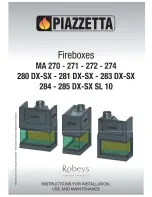
DRAFT REQUIREMENTS
Draft is the force which moves air from the appliance up through the
chimney. The amount of draft in your chimney depends on the length of
the chimney, local geography, nearby obstructions and other factors. Too
much draft may cause excessive temperatures in the appliance and may
damage the catalytic combustor. Inadequate draft may cause backpuffing
into the room and `plugging’ of the chimney or the catalyst.
Inadequate draft will cause the appliance to leak smoke into the room
through appliance and chimney connector joints.
An uncontrollable burn or excessive temperature indicates excessive draft.
THE CHIMNEY SYSTEM
Chimney Installation Notes
1. This appliance is equipped with a universal vent collar that will require
the first vent section of pipe to be secured with four screws to the
collar (equally spaced around circumference).
2. If possible, install an interior chimney as it will provide better perfor-
mance. In areas with continuous temperatures below -18° C (0° F),
the use of an exterior chimney increases the likelihood of operating
problems such as low draft, high rate of creosoting, and poor start-up
characteristics. Exterior chimneys are also prone to down-draft and
flow reversal. Installations, which are located on lower floors in the
house, such as in a basement, in combination with outside chimney,
are especially prone to flow reversal.
3. The IHP fireplace model Ladera™ CAT may be installed only with
Security Chimneys
®
6” diameter chimney systems
*
or DuraVent
model DuraTech
®
DTC chimney systems
**
. The Ladera CAT fireplace
may also be installed with a 7’’ chimney system (ASHT
*
or HT6103
*
)
using the optional 6AW7
*
7’’ adaptor (7’’ AC chimney is not allowed).
For more information refer to chimney installation manual.
4. A chimney venting a fireplace shall not vent any other appliance.
5. The minimum chimney height is twelve (12) feet (3.7 m). In altitude,
add 18” (450 mm) to the chimney for every 2,000 feet (600 m) above
sea level.
6.
All chimney
*
installations must include at least one support.
Re-
ducing the amount of chimney weight on the fireplace will help avoid
the noise created when the fireplace expands. This can be achieved
by having the chimney supported by the supports. The maximum
chimney length that can be supported by the fireplace is nine (9) feet
(2.75 m) for S-2100+/, twelve (12) feet (3.7 m) for ASHT+
/
/ DuraTech DTC
**
and 26 feet (8 m) for AC chimney.
7. The chimney must extend at least three (3) feet (915 mm) above its point
of contact with the roof and at least two (2) feet (610 mm) higher than
any wall, roof or building within ten (10) feet (3m) of it (
Figure 30
).
NOTE:
2" clearance to combustibles around chimney components required.
NOTE:
Blown or fill type insulation materials must not be in contact with
the fireplace or in the enclosure frame as described in ‘’Enclosure’’ section.
NOTE:
Local codes may not require firestopping at the ceiling levels for
outside chase installations. However, it is recommended for safety and
the reduction of heat loss.
Figure 30
ten (10) feet
three (3) feet Min.
two (2) feet Min.
*
Available from Security Chimneys
®
**
Available from DuraVent
®
20
NOTE: DIAGRAMS & ILLUSTRATIONS ARE NOT TO SCALE.
8. If the chimney extends higher than five (5) feet (1,500 mm) above its
point of contact with the roof, it must be secured using a roof brace.
9. A rain cap must be installed on top of the chimney. Failure to install
a rain cap may cause corrosion problems.
10. Cut and frame square holes in all floors, ceilings, and roof that the
chimney will go through to provide a 2” (50 mm) clearance between
the chimney and any combustible materials. Do not fill this 2” space
with insulation or any other combustible material.
11. Portions of the chimney which may extend through accessible spaces
must be enclosed to avoid contact with combustible materials or
damage to the chimney.
12. When offsets are used, the pipe may not penetrate a ceiling or floor
unless it is running vertical (no 30° offsets).















































